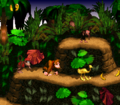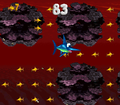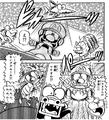Animal token
| Animal token | |
|---|---|
    In clockwise order: a Rambi Token, an Expresso Token, a Winky Token, and an Enguarde Token | |
| First appearance | Donkey Kong Country (1994) |
| Latest appearance | Donkey Kong Country (Game Boy Advance) (2003) |
| Effect | Collecting three of a kind takes Donkey Kong and Diddy to a Token Area. |
Animal tokens[1][2] (also formatted as Animal Tokens),[2] also known as Golden Tokens,[3] Golden Statues,[4] Golden Medallions,[5] and statues,[6] are large collectible golden figures of all four mountable Animal Friends in Donkey Kong Country. The specific ones include the Rambi Token[7] (or Rambi Medallion),[7] the Expresso Token[8] (also called the Golden Expresso Token[9] or Golden Expresso Animal Token[2]), the Enguarde Token,[10] and the Winky Token[11] (or Winky Medallion).[12] Animal tokens most often appear in hard-to-reach places, but they are sometimes rewarded if Donkey Kong and Diddy Kong complete a Bonus Level. When the Kongs collect an animal token, it floats to the top of the screen, makes a small noise, and goes offscreen. Additional tokens of the same Animal Friend are also briefly displayed, if the Kongs have any. When the Kongs collect three tokens of the same Animal Friend, they are warped to a bonus Token Area[3] (also named Token Bonus Area,[13] Animal Bonus Level,[14] or bonus level[2]), where the player controls the corresponding Animal Friend. The object in a Token Area is to collect as many mini Animal Tokens within the time limit, which always begins at 99, and the countdown speed differs between areas. When the timer runs out, the mini Animal Tokens are counted down, with every 100 of them being exchanged for an extra life. The additional tokens are lost.
A big Animal Token of the Animal Friend is hidden in its secret area. This token doubles the player's count of mini Animal Tokens.
In Super Mario-kun Volume 15, Rambi, Winky, and Enguarde give Mario their animal token to turn him into Golden Mario, giving him enough power to defeat King K. Rool.
Gallery[edit]
An Expresso Token is discovered by Donkey Kong and Diddy in Jungle Hijinxs.
Names in other languages[edit]
| Language | Name | Meaning | Notes |
|---|---|---|---|
| Italian | Simbolo di animale[15] | Animal symbol | Donkey Kong Country (SNES) |
| Animali d'oro[16][17] | Gold animals | Donkey Kong Country (GBC/GBA) | |
| Spanish | Ficha de animal[18] | Animal token | |
| Spanish (Latin America) | Token animal[19] | Animal token |
References[edit]
- ^ 1994. Donkey Kong Country instruction booklet. Nintendo of America (American English). Page 19.
- ^ a b c d Donkey Kong Jungle Action Special. Page 34.
- ^ a b 1994. Donkey Kong Country Player's Guide. Nintendo of America (American English). Page 23.
- ^ November 1994. Nintendo Power Volume 68. Page 56.
- ^ November 1994. Nintendo Power Volume 66. Page 11 and 15.
- ^ November 1994. Nintendo Magazine System (UK) issue 26 (NMS Special). Page 10-11.
- ^ a b 1994. Donkey Kong Country Player's Guide. Nintendo of America (American English). Page 111.
- ^ 1994. Donkey Kong Country Player's Guide. Nintendo of America (American English). Page 41, 57.
- ^ 1994. Donkey Kong Country Player's Guide. Nintendo of America (American English). Page 35, 41, 55.
- ^ 1994. Donkey Kong Country Player's Guide. Nintendo of America (American English). Page 64, 65, 99.
- ^ 1994. Donkey Kong Country Player's Guide. Nintendo of America (American English). Page 31, 70.
- ^ November 1994. Nintendo Power Volume 66. Page 10.
- ^ 1994. Donkey Kong Country Player's Guide. Nintendo of America (American English). Page 24-26.
- ^ Hodgson, David S. J. (June 17, 2003). Donkey Kong Country Prima's Official Strategy Guide. Prima Games (American English). ISBN 0-7615-4334-1. Page 7.
- ^ Donkey Kong Country Italian instruction booklet. Page 19.
- ^ Donkey Kong Country (GBC) European booklet. Page 110.
- ^ Donkey Kong Country (GBA) European booklet. Page 101.
- ^ Donkey Kong Country Spanish instruction booklet. Page 19.
- ^ Club Nintendo (Chile) La Jungla de Donkey Kong: Edición Especial. Page 45.










